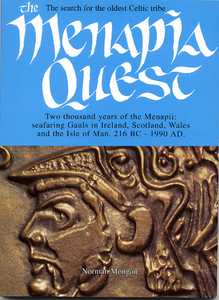The Menapia Quest by Norman Mongan

Who are the Irish?
Where did they come from?
This is the odyssey of the Menapii, the oldest traceable Celtic tribe in Europe.
They are the only tribe for whom historical evidence has survived both in Ireland and the Continent.
The Menapii, a Gaulish maritime tribe inhabiting the dense forests of the Rhine estuary on the North Sea coast, were first mentioned by Julius Caesar in 57 BC. During the Gallic War he singled them out as the only tribe never to surrender to his legions. As part of the Belgae, the Belgic tribal confederation, they had for centuries valiantly resisted encroaching Germanic tribes.
Celtic seafarers and traders, their ships had sailed the Irish Sea for centuries BC, establishing trading colonies on the Irish, Scottish,Welsh and Manx coasts, as confirmed by ancient and modern placenames. They worshipped Manannan mac Lir, their Celtic sea-god; a renown navigator, merchant and magician.
Carausius, a 3rd century AD Menapian admiral, became the first Celtic Emperor of the Britons(297-293 AD). (See cover photo).
The Menapii are the only known Celtic tribe specifically named on Ptolemy’s 150 AD map of Ireland, where they located their first colony- Menapia – on the Leinster coast circa 216 BC. They later settled around Lough Erne, becoming known as the Fir Manach, and giving their name to Fermanagh and Monaghan. Mongan mac Fiachna, a 7th century King of Ulster, is the protagonist of several legends linking him with Manannan mac Lir. They spread across Ireland, evolving into historic Irish (also Scottish and Manx) clans whose descendants are found worldwide today:
Mooney – Meaney – Meeny – McWeeny – Monaghan – Monahan – Mannion – Manning – Mongan – Mangan – Minogue – Minnock – Mannix – Managhan – Mongey – Mongavin – McMannion – McMenamin – McMonagle etc.
All Menapian clans whose histories are traced here for the first time in this pioneer work.
The author, who spent 15 years resurrecting the long-lost saga of the indomitable Menapii, sheds new light on the virtually unexplored period of Irish history, and its European Celtic heritage – a fascinating unbroken two thousand year perspective.
Here is a voyage to the root of Celtic roots.
“An astonishing achievement…of sound scholarship…speculative and antiquarian.”
Dr Alfred Smyth Chair of Medieval History University of Kent, Canterbury Author of Celtic Leinster
“(In) this well researched work…of considerable interest…by taking one Celtic tribe, the author has found an angle from which the history of Celtic Europe, and in particular Celtic Ireland can very usefully be viewed…I salute the diligent research.”
Professor Liam de Paor late of Dept of Irish History Boston College, Boston, Mass.
“With (its) painstaking detective work,…(Mongan’s) book…. coincides with a renowned interest in Celtic culture across Europe : London’s British Museum recently opened a permanent display of Iron Age artifacts, while new exhibitions in Belgium explore the country’s Celtic heritage.”
Ian Ramsey Passport Sabena, Belgian airlines in-flight magazine
“I sincerely recommend this book to anybody interested in our past and people….for the deep amount of research it contains.”
Dr Hugh Weir Clare Champion
“The author…has taken sources…provided them with credibility,building up a work which could well be an exemplar for further studies of the histories of Celtic tribes of Europe. Most commendably of all, for such a difficult subject, is the readability of this book.”
Family History Magazine Canterbury, Kent, UK
Norman Mongan Interview – Celtic Cafe“Two thousand years of the Menapii: seafaring Gauls in Ireland, Scotland, Wales and the Isle of Man. 216 B.C. – 1990 A.D.” ….
Books Ireland
